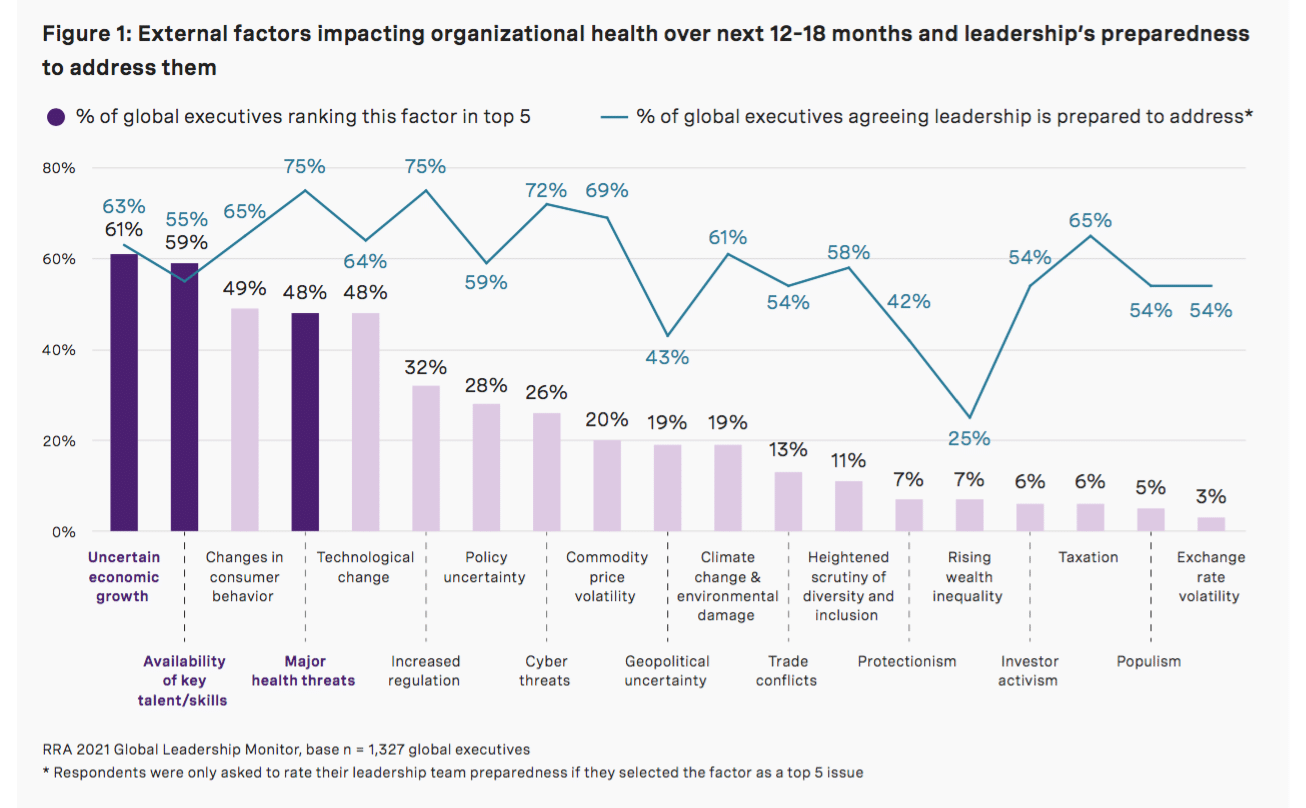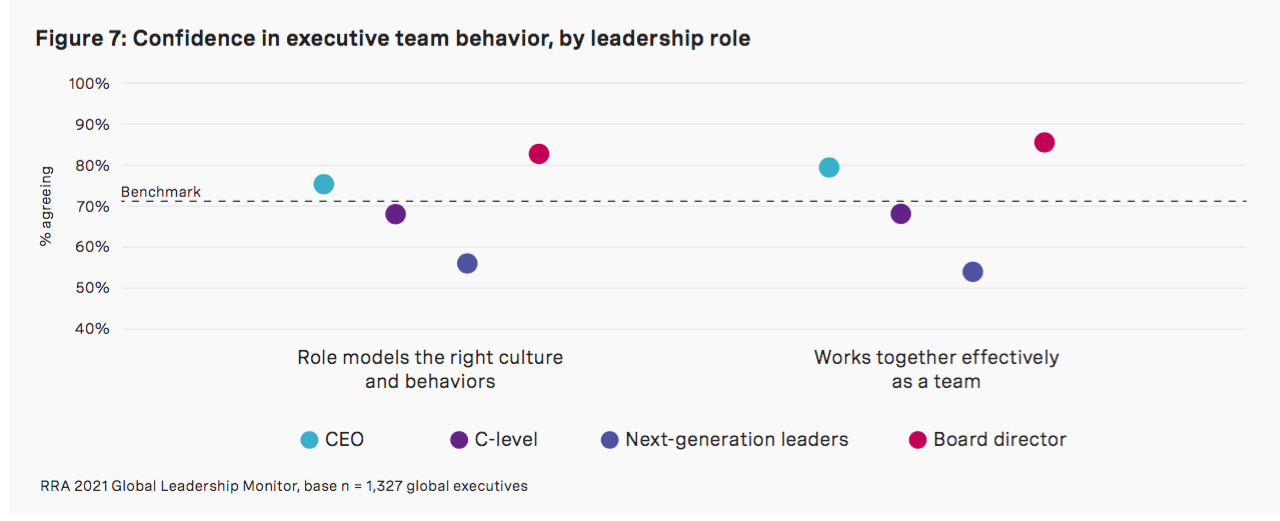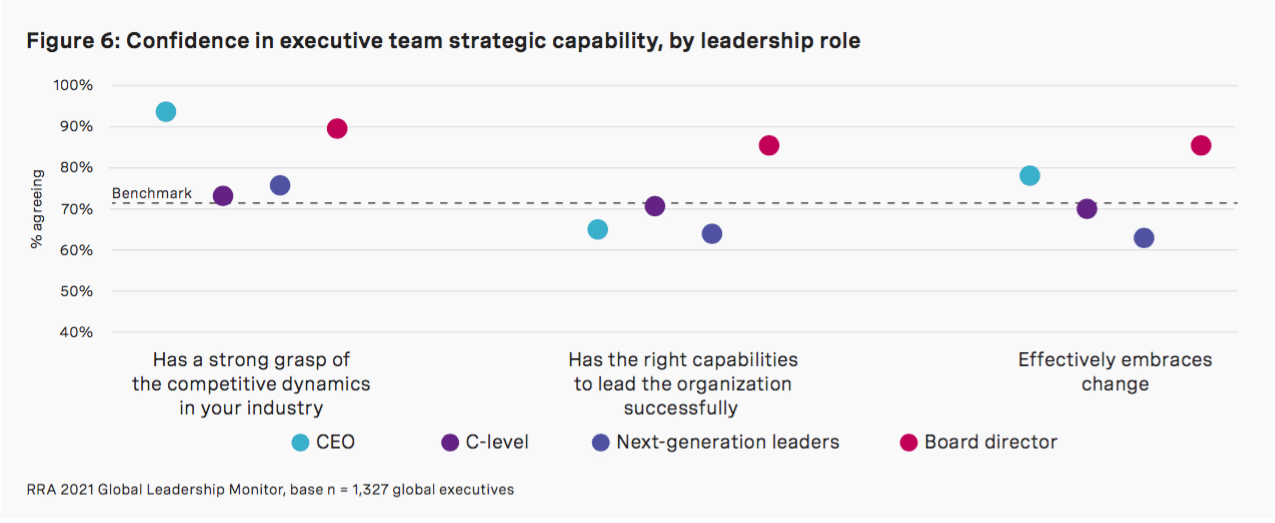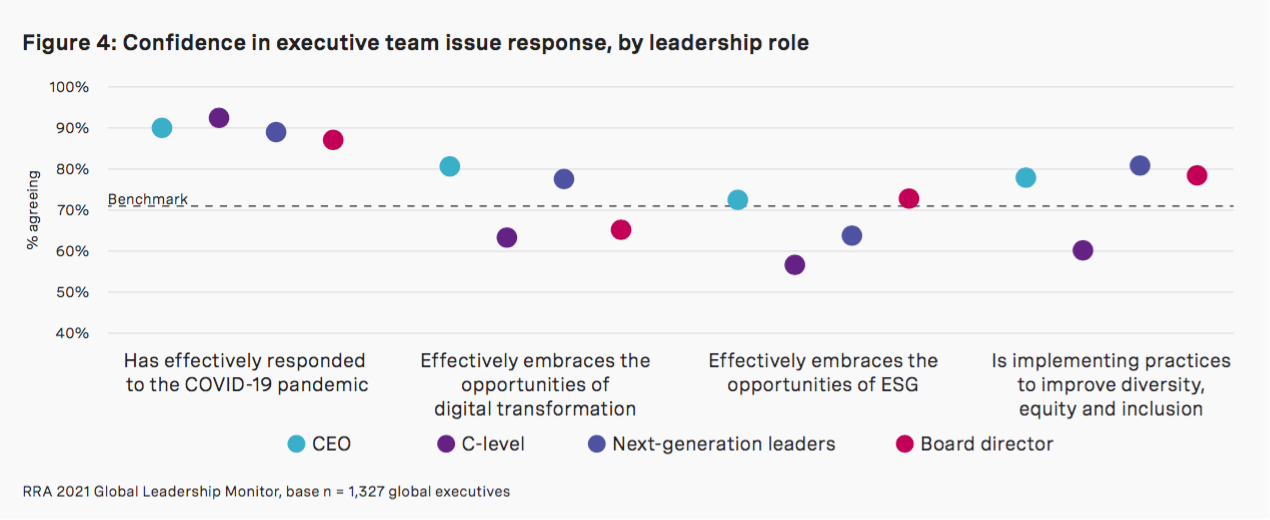As it has for everyone else, the COVID experience has been catastrophic for business leaders and decision makers, but also an opportunity to learn more about their ability to adapt and manage key relationships. New research from leadership advisory and executive search firm Russell Reynolds Associates sheds light on the significant challenges and impacts business leaders have faced since the start of pandemic, as well as their confidence and concerns in navigating the road ahead.
For its 2021 Global Leadership Monitor, the first report of its kind to track top business issues and leadership preparedness to face them, Russell Reynolds Associates surveyed 1,327 business leaders across 53 countries and all major industry sectors. The results highlight several pertinent issues for leadership teams, including concern about talent availability, leadership softness on issues of ESG and DE&I, and disconnects between boards and management teams.
Despite the challenges and concerns leaders expressed, most respondents expressed confidence in their collective ability to handle the residual commercial-focused business issues stemming from the pandemic, including economic uncertainty, technological disruption and changing consumer behavior.
“Leaders have been challenged this last year, and many have succeeded against the odds,” said Clarke Murphy, CEO of Russell Reynolds Associates, in a news release. “As leaders work on their growth plans, it will be very important that they zero in on leadership capability and culture. The long-term ramifications of the pandemic, as well as the critical dynamics of ESG and DE&I, will reveal which leadership teams have simply been good crisis managers, and which have built the foundations for their organizations to emerge stronger.”
Some global themes and findings from the report include:
Employees edge out investors and the board as key stakeholders
Customers dominate as the most critical stakeholder group and employees come second followed by investors and board.
Board and C-suite disconnect
Four in ten CEOs and other C-suite leaders don’t believe the executive team receives good advice and input from the board.
Leaders growing increasingly interested in new opportunities
Seventy-three percent of next generation leaders are willing to change employers for the right opportunity.
Confidence in succession strategies low
Only 38 percent of leaders believe their executive leadership team has a successful strategy for C-level succession.
Talent availability is the top challenge for leaders
Fifty-nine percent of leaders cite availability of key talent and skills as a top threat to their business over the next year (second only to uncertain economic growth), and it is the concern they are least prepared to address.
Greater alignment needed around ESG, DE&I
Seventy-four percent of CEOs and board leaders agree the leadership team is effectively embracing the opportunities of ESG, yet only 57 percent of other C-suite executives do.
“The challenges highlighted by our analysis will be most successfully addressed by leadership teams that prioritize culture, optimize relationships among top teams and boards, and manage ESG imperatives as rigorously as they manage strategic and operational plans,” said Murphy.
Geographic standouts:
Americas
Talent tops the list in the Americas when it comes to external factors expected to have the most impact on the health of organizations over the next 12-18 months, with 60 percent of respondents listing availability of key talent and skills as their number one concern. The concern is shared to a similar extent in Asia and Europe with 55 percent and 56 percent of respondents putting availability of talent, just slightly behind concerns around economic uncertainty.
Executives across countries lack confidence in succession plans, and in the U.S. respondents are just as concerned when it comes to having an effective strategy for C-Suite leadership succession with only 36 percent respondents agreeing. Combined with high levels of openness to new job opportunities (66 percent, up 7 percent from pre-pandemic levels), this could create real leadership talent retention risk for organizations in the US.
Europe
While relatively few leaders noted heightened scrutiny of diversity and inclusion as a top 5 issue (11 percent), of those leaders that did, European respondents were much less likely to be confident in their leadership team’s preparedness to address it. Only 36 percent feel their organization’s leadership is prepared; that’s compared to 63 percent and 67 percent in the U.S. and Asia respectively. It is worth noting that the UK is an outlier within Europe at 62%.
In Europe, 33 percent of executives believe that climate change is a leading risk to the health of their organization; in contrast, only 18 percent of executives in America and 9% of executives in Asia share this view.
Asia
Sentiment towards company leadership’s preparedness to respond to technological change is marginally lower in Asia (59 percent) than in the Americas (63 percent) and notably lower than in Europe (72 percent).
Respondents in China (81 percent) believe their leadership is prepared to respond to forthcoming changes in consumer behavior, that’s the highest among a list of major markets, with just 66 percent of U.S. respondents feeling the same level of confidence.
Russell Reynolds Associates surveyed its global network of executives using an online/mobile survey in February and March of 2021. The 1,327 business leaders surveyed represent:
- 53 countries in Africa, Asia, Americas, Europe, Middle East and Oceania.
- CEOs, C-Level leaders (reporting to CEO), next generation leaders (one to two levels below the C-Suite), and board directors.
- Sectors including Consumer, Financial Services, Healthcare, Technology, Industrial and Natural Resources, and Professional and Business Services.
And a variety of business sizes and types:
- 60 percent with annual revenues of $1billion USD or higher
- 52 percent with 5,000 global employees or more
- 50 percent publicly traded, 17 percent private equity or venture backed, and 28 percent private ownership









